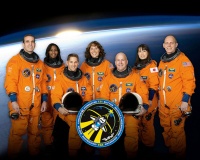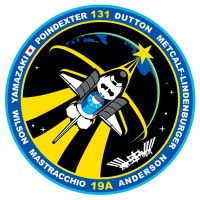STS-131
From The Space Library
 | |
| Organization | National Aeronautics and Space Administration (UnitedStates) |
|---|---|
| Mission type | Human Crew,Resupply/Refurbishment/Repair |
| Launch date | April 5, 2010 |
| Launch vehicle | Space Shuttle |
| Launch site | Cape Canaveral, United States |
| COSPAR ID | 2010-012A |
| Inclination | 51.6 degrees |
| Experiments | Here |
| Alternate Names | 36507 |
| Additional Information | Here |
| Data Collection | Here |
| Payload Mass Up | 14642.86 kg |
| Payload Mass Down | 10735.91 kg |
| Orbiter | Discovery |
| Lift Off Mass | 2,055,340.45 kg |
| Orbiter Weight at Liftoff | 121,301.82 kg |
| Orbiter Weight at Landing | 102,253.18 kg |
| Landed | 9:08 a.m. EDT, concrete runway 33, Kennedy Space Center, Fla. |
| Orbits of Earth | 238 |
| Orbital Altitude | 185 nautical miles |
Contents |
[edit] Crew
- Commander: Alan G. Poindexter
- Pilot: James P. Dutton Jr.
- Payload Commander:
- Mission Specialist 1: Richard A. Mastracchio
- Mission Specialist 2: Dorothy M. Metcalf-Lindenburger
- Mission Specialist 3: Clayton C. Anderson
- Mission Specialist 4: Stephanie D. Wilson
- Mission Specialist 5: Naoko Yamazaki, Japan Aerospace Exploration Agency (JAXA)
- Payload Specialist 1:
- Payload Specialist 2:
ISS/Mir Crew Transport
[edit] Mission
STS 131 was an American shuttle craft carrying seven astronauts, supplies and hardware for the International Space Station. It launched from Cape Canaveral on 05 April 2010 at 10:21 UT. The craft docked with the ISS on 07 April 2010 at 07:44 UT. The mission objectives included the transfer of approximately 7700 kg of materials and scientific hardware from the Leonardo Multi-Purpose Logistics Module and performing three spacewalks to replace an ammonia coolant tank on the exterior of the ISS. The shuttle left the ISS carrying back to Earth a payload rack from the exterior of the European Columbus module and the Japanese Experiment Module SEED payload. The STS 131 mission completed with a landing at Cape Canaveral on 20 April 2010 at 13:08 UT.
[edit] EVA
Extravehicular Activity (EVA) conducted by Richard Mastracchio and Clayton Anderson during three spacewalks for a total of 20 hours, 17 minutes. EVA 1, 6 hours, 27 minutes; Mastracchio and Anderson moved a new ammonia tank for the station's cooling system from Discovery's cargo bay to a temporary parking place on the ISS. They also retrieved a seed experiment from the Kibo Laboratory Exposed Facility and replaced a rate gyro assembly on one of the truss segments. EVA 2, 7 hours, 26 minutes; Stephanie Wilson and James Dutton used Canadarm2 to move the spent ISS ammonia tank to one of the mobile equipment carts on the tracks of the ISS truss. Mastracchio and Anderson temporarily stowed the tank there until their third spacewalk. Wilson and Dutton then used Canadarm2 to retrieve the new tank from its temporary location on the Quest airlock, and Mastracchio and Anderson secured the tank in place. They also installed two radiator grapple fixture stowage beams on the P1 truss. EVA 3, 6 hours, 24 minutes; Wilson and Dutton used Canadarm2 to lift the depleted tank from its temporary storage location and moved it to Discovery's cargo bay. The depleted tank will be refurbished, refilled, and brought back to the ISS as a spare. Mastracchio and Anderson finished connecting fluid lines to the new ammonia tank and retrieved micrometeoroid shields from outside the airlock. Mastracchio also prepared cabling at the Z1 truss for installation of a communications antenna during the STS-132 mission.
[edit] Payload
ISS Assembly Flight 19A; Leonardo Multipurpose Logistics Module; Lightweight Multi-Purpose Experiment Support Structure Carrier (LMC)
[edit] Books about the Space Shuttle Program
Buy This Book Click here |
Buy This Book here |
Buy This Book Click here |
Buy This Book Click here |





